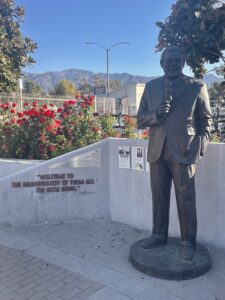 Origins
Origins
Located in Pasadena, California, the Rose Bowl Stadium has a rich history that dates back to the late 19th century. From its humble beginnings for horse parades and public games, it has evolved into a national symbol for football and a renowned venue. This article explores the origins of the Rose Bowl, its construction, preservation, and some of its most significant historical moments.
In 1890, the Valley Hunt Club organized the first-ever Tournament of Roses parade and games. This event featured flower-decorated horses and buggies, and public games held east of Los Robles. In 1902, the first Tournament of Roses East-West football game took place. This marked the beginning of a new tradition. Ostrich races and even an elephant-camel race took place in festivities in 1913. Animals added an exotic touch to the New Year’s Day festivities. Then, in 1916, football returned to the Tournament Park, and the “Rose Bowl Game” was born.
Rose Bowl Construction
Recognizing the need for a new venue to host the annual football game, Tournament President William L. Leishman envisioned the construction of a stadium. In 1922, architect Myron Hunt came on board to design the Rose Bowl Stadium. Inspired by Yale’s horseshoe-shaped stadium, Hunt’s design featured a seating capacity of 57,000. The stadium was completed at a cost of $272,198, and it quickly became a beloved landmark. Over the years, the Rose Bowl underwent several expansions and improvements. In 1928, the south end enclosed for expansion. This added seating for an additional 19,000 spectators, bringing the total capacity to 76,000.
In 1931, concrete was used to reinforce wooden sections of the stadium, resulting in an additional 10,000 seats. Later in 1950, the Rose Bowl became the first stadium in the United States to host an event with over 100,000 attendees, thanks to increased capacity. In 1972, permanent seats install in the north and south ends, further expanding the seating capacity to 104,594. Additionally, five concession stands were constructed to enhance the spectator experience. A year later, the largest crowd in bowl game history, with 106,869 attendees, witnessed a thrilling match between the University of Southern California and The Ohio State University.
Preservation Award Honors Rose Bowl
In 2011, the Rose Bowl Stadium underwent a $152 million renovation, which aimed to preserve its historical significance while modernizing facilities. This project was the result of a decade-long search for a compatible design and economic solution. The renovation included the construction of a new pavilion to replace an outdated and non-historic pavilion, providing press and premium seating. Other notable improvements include updating concessions and restroom facilities. Also, installing visually coherent video and sign boards, and widened entry tunnels. The Rose Bowl Stadium was recognized for its preservation efforts and received the prestigious 2018 Preservation Design Award. This acknowledgment highlights the stadium’s commitment to maintaining its historical integrity while adapting to the changing needs of modern events.
 Historical Moments
Historical Moments
The Rose Bowl Stadium has witnessed numerous historical moments that have solidified its status as an iconic venue. It served as a venue for the 1932 and 1984 Olympics, showcasing the international significance of this historic stadium. Additionally, the Rose Bowl has hosted World Cup soccer matches, five Super Bowl games, and numerous high-profile concerts, solidifying its reputation as a versatile and highly sought-after venue.
The Rose Bowl Stadium’s journey from a small parade ground to an iconic venue is a testament to its enduring legacy. With its rich history, architectural grandeur, and ability of hosting a range of events, the Rose Bowl continues to captivate audiences and leave a lasting impression. As a symbol of American football and a cultural landmark, the Rose Bowl Stadium holds a special place in the hearts of sports fans and history enthusiasts.
